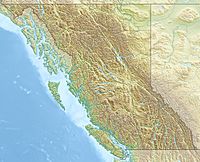Mount Brew (Cheakamus River) facts for kids
Quick facts for kids Mount Brew |
|
|---|---|
| Highest point | |
| Elevation | 1,757 m (5,764 ft) |
| Prominence | 127 m (417 ft) |
| Geography | |
| Location | British Columbia, Canada |
| Parent range | Pacific Ranges, Coast Mountains |
| Geology | |
| Age of rock | Pleistocene |
| Mountain type | Subglacial mound |
| Volcanic arc/belt | Canadian Cascade Arc Garibaldi Volcanic Belt |
| Last eruption | Pleistocene |
| Climbing | |
| Easiest route | off trail hike |
Mount Brew is a cool, rounded mountain found in southwestern British Columbia, Canada. It's about 18 kilometers (11 miles) southwest of Whistler. This mountain is part of the Pacific Ranges in the larger Coast Mountains.
Near the top of Mount Brew, there's a public cabin called Brew Hut. It's run by the Varsity Outdoor Club. The area around the mountain is super popular for outdoor fun. People love to go hiking there in the summer. When winter and spring arrive, it becomes a great spot for backcountry ski touring.
How Mount Brew Was Formed
Mount Brew is actually a special kind of volcano! It's part of the Mount Cayley volcanic field, which is in the middle of the Garibaldi Volcanic Belt. This belt is a section of the Canadian Cascade Arc.
Mount Brew was created during a time called the Pleistocene period. This was a long time ago, when much of the Earth was covered in huge sheets of ice, like during the last glacial period. The volcano formed when lava erupted underneath this thick glacial ice.
What is a Subglacial Mound?
When Mount Brew was forming, the eruption started with a lot of power. However, it didn't keep going strong enough to break through all the ice and water above it. If it had, it might have become a tuya. A tuya is a flat-topped, steep-sided volcano that forms when lava erupts through a glacier or ice sheet.
Instead, because the eruption wasn't strong enough to fully break through, it created something called a subglacial mound. Think of it like a big bump or hill that formed under the ice. The lava cooled quickly because of the ice and water, shaping Mount Brew into the rounded mountain we see today.


